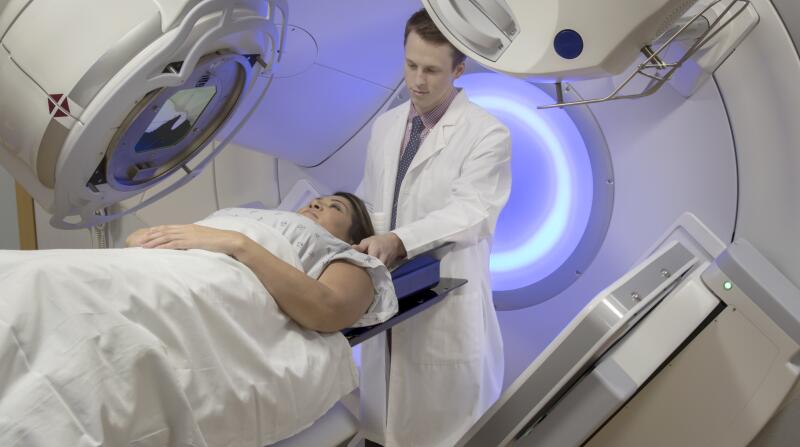Leukemia: 10 Things to Know

Medically Reviewed By William C. Lloyd III, MD, FACS
Written By Sarah Lewis, PharmD on February 24, 2021
-
 Leukemia FactsLeukemia is cancer of the white blood cells. This cancer starts in the bone marrow where blood cells develop, and as the cancer grows, it can crowd out normal blood cells. Each year, more than 60,000 Americans find out they have some form of leukemia. Here are some of the most important facts to know about leukemia.
Leukemia FactsLeukemia is cancer of the white blood cells. This cancer starts in the bone marrow where blood cells develop, and as the cancer grows, it can crowd out normal blood cells. Each year, more than 60,000 Americans find out they have some form of leukemia. Here are some of the most important facts to know about leukemia. -
 1. There are four main types of leukemia.The main types of leukemia are acute lymphoblastic leukemia (ALL), acute myeloid leukemia (AML), chronic lymphocytic leukemia (CLL), and chronic myeloid leukemia (SML). Acute leukemias grow quickly and tend to cause symptoms quickly. Chronic leukemias usually grow more slowly and cause fewer symptoms. Some leukemias are more common in children, while others tend to affect adults.
1. There are four main types of leukemia.The main types of leukemia are acute lymphoblastic leukemia (ALL), acute myeloid leukemia (AML), chronic lymphocytic leukemia (CLL), and chronic myeloid leukemia (SML). Acute leukemias grow quickly and tend to cause symptoms quickly. Chronic leukemias usually grow more slowly and cause fewer symptoms. Some leukemias are more common in children, while others tend to affect adults. -
-
 2. It may take years before leukemia symptoms occur.When symptoms develop, it’s because of problems with blood cells. Abnormal white blood cells or low levels of healthy white blood cells make it hard for your body to fight infections. Symptoms can include fevers, chills, frequent infections, and swollen glands. Low levels of red blood cells—or anemia—can cause weakness and tiredness. Low platelet levels can cause easy bleeding, bruising, and tiny red spots under the skin. Other symptoms include night sweats, headaches, joint and bone pain, weight loss, loss of appetite, and swollen or bleeding gums.
2. It may take years before leukemia symptoms occur.When symptoms develop, it’s because of problems with blood cells. Abnormal white blood cells or low levels of healthy white blood cells make it hard for your body to fight infections. Symptoms can include fevers, chills, frequent infections, and swollen glands. Low levels of red blood cells—or anemia—can cause weakness and tiredness. Low platelet levels can cause easy bleeding, bruising, and tiny red spots under the skin. Other symptoms include night sweats, headaches, joint and bone pain, weight loss, loss of appetite, and swollen or bleeding gums. -
 3. Certain factors increase the risk of developing leukemia.Anyone can get leukemia, but the risk is greater if you are male, white, and older than 55. Other risk factors include smoking, having cancer chemotherapy, radiation exposure, and exposure to the chemical benzene, which is found in chemical plants and gasoline industries. Being born with certain genetic conditions, including Down syndrome, also increases the risk. Keep in mind, not everyone with risk factors will develop the disease.
3. Certain factors increase the risk of developing leukemia.Anyone can get leukemia, but the risk is greater if you are male, white, and older than 55. Other risk factors include smoking, having cancer chemotherapy, radiation exposure, and exposure to the chemical benzene, which is found in chemical plants and gasoline industries. Being born with certain genetic conditions, including Down syndrome, also increases the risk. Keep in mind, not everyone with risk factors will develop the disease. -
 4. Blood tests and bone marrow tests can diagnose leukemia.Your doctor might suspect you have leukemia from your symptoms and your physical exam. However, you will need some tests to confirm the diagnosis. This includes blood tests, such as a complete blood count (CBC) and a peripheral blood smear to look at the cells under a microscope. Bone marrow testing may also be necessary to determine the type of leukemia and how advanced it is.
4. Blood tests and bone marrow tests can diagnose leukemia.Your doctor might suspect you have leukemia from your symptoms and your physical exam. However, you will need some tests to confirm the diagnosis. This includes blood tests, such as a complete blood count (CBC) and a peripheral blood smear to look at the cells under a microscope. Bone marrow testing may also be necessary to determine the type of leukemia and how advanced it is. -
 5. A complete diagnosis is necessary to stage leukemia.After diagnosing leukemia, your doctor may order imaging exams, such as a chest X-ray, CT scan, and MRI, to determine the extent of cancer. Your doctor may order a lumbar puncture to examine fluid from the spinal canal to investigate possible brain involvement. Genetic testing of blood cells or bone marrow samples may also be necessary for a complete diagnosis. All of this information helps your doctor stage and classify the leukemia and plan the most effective treatment.
5. A complete diagnosis is necessary to stage leukemia.After diagnosing leukemia, your doctor may order imaging exams, such as a chest X-ray, CT scan, and MRI, to determine the extent of cancer. Your doctor may order a lumbar puncture to examine fluid from the spinal canal to investigate possible brain involvement. Genetic testing of blood cells or bone marrow samples may also be necessary for a complete diagnosis. All of this information helps your doctor stage and classify the leukemia and plan the most effective treatment. -
-
 6. Leukemia type and stage guides treatment decisions.Your doctor will look at blood counts, examine blood cells under a microscope, and make note of any lymph node involvement to determine the stage of leukemia. Staging varies depending on the type of leukemia. Once your doctor knows the stage, he or she can develop a treatment plan that is right for you.
6. Leukemia type and stage guides treatment decisions.Your doctor will look at blood counts, examine blood cells under a microscope, and make note of any lymph node involvement to determine the stage of leukemia. Staging varies depending on the type of leukemia. Once your doctor knows the stage, he or she can develop a treatment plan that is right for you. -
 7. Chemotherapy is the main treatment for most types of leukemia.Chemotherapy kills rapidly dividing cells, including cancer cells and some normal cells. This can cause side effects, such as hair loss and fatigue. Chemotherapy drugs travel through your body to reach cancer cells in your bone marrow. Doctors often use more than one drug to treat leukemia and give more than one course of treatment. If leukemia affects the area around your brain or spinal cord, doctors will give intrathecal chemotherapy, which is an injection into the fluid surrounding your spinal cord.
7. Chemotherapy is the main treatment for most types of leukemia.Chemotherapy kills rapidly dividing cells, including cancer cells and some normal cells. This can cause side effects, such as hair loss and fatigue. Chemotherapy drugs travel through your body to reach cancer cells in your bone marrow. Doctors often use more than one drug to treat leukemia and give more than one course of treatment. If leukemia affects the area around your brain or spinal cord, doctors will give intrathecal chemotherapy, which is an injection into the fluid surrounding your spinal cord. -
 8. Stem cell transplant may be an option.Stem cell transplant uses high doses of chemotherapy followed by replacement of bone marrow cells, called stem cells. Before a transplant, high doses of chemotherapy are administered to wipe out your leukemic bone marrow, which can lead to severe infections and bleeding. The newly transplanted stem cells will generate the healthy replacement blood cells you need to prevent infection and bleeding.
8. Stem cell transplant may be an option.Stem cell transplant uses high doses of chemotherapy followed by replacement of bone marrow cells, called stem cells. Before a transplant, high doses of chemotherapy are administered to wipe out your leukemic bone marrow, which can lead to severe infections and bleeding. The newly transplanted stem cells will generate the healthy replacement blood cells you need to prevent infection and bleeding. -
 9. Targeted therapy, immunotherapy, and radiation therapy may also be useful.Targeted therapies are medicines that target specific markers present only on cancer cells. In some cases, targeted therapies work when standard chemotherapy does not. Immunotherapy uses man-made antibodies to help your body’s immune system fight leukemia. And radiation therapy may help when leukemia has spread to your brain or spinal cord. It can also help relieve bone pain and symptoms from a large tumor in your chest.
9. Targeted therapy, immunotherapy, and radiation therapy may also be useful.Targeted therapies are medicines that target specific markers present only on cancer cells. In some cases, targeted therapies work when standard chemotherapy does not. Immunotherapy uses man-made antibodies to help your body’s immune system fight leukemia. And radiation therapy may help when leukemia has spread to your brain or spinal cord. It can also help relieve bone pain and symptoms from a large tumor in your chest. -
 10. You can take charge of your health.Prevention strategies for any cancer involve reducing risk factors that are within your control. Right now, there is no definitive way to prevent leukemia, but not smoking is the most important step you can take to lower your risk. Also, let your doctor know if you are at risk of exposure to benzene at work. And always tell your doctor if you have unusual symptoms that last for more than a couple of weeks. In general, catching cancer early offers the best chance of successful treatment.
10. You can take charge of your health.Prevention strategies for any cancer involve reducing risk factors that are within your control. Right now, there is no definitive way to prevent leukemia, but not smoking is the most important step you can take to lower your risk. Also, let your doctor know if you are at risk of exposure to benzene at work. And always tell your doctor if you have unusual symptoms that last for more than a couple of weeks. In general, catching cancer early offers the best chance of successful treatment.
Leukemia: 10 Things to Know

















